
Submissions 101
 So, you’ve written a children’s book and you’re ready to submit it to an agent and/or a publisher. The following are the industry standards for manuscript submission, regardless of whether the manuscript is for a picture book, a chapter book or a novel:
So, you’ve written a children’s book and you’re ready to submit it to an agent and/or a publisher. The following are the industry standards for manuscript submission, regardless of whether the manuscript is for a picture book, a chapter book or a novel:
Standard white paper – Don’t even think of using colored paper!
Black ink – Don’t even think of using colored ink!
Double-spaced narrative text. No dummies or proposed lay-outs.
Times or Times New Roman, #12 font. Arial and Cambria are okay too, as they’re close enough to the size of Times New Roman, but you’re really safe with Times.
1¼ inch margins (1.25) on either side, justified left and ragged on the right. That means all straight on the left margin, and uneven on the right.
Paragraphs and dialogue indented, with quotation marks around all dialogue. Every time a new person starts to speak, it’s a new indent.
Title page – a separate sheet attached to the front of your manuscript, which includes not only the working title of the manuscript and your name but also your contact information, the date, and the word count. (Yes, you must include the word count. Microsoft Word has a handy word count tool under “Tools.”) Title and byline should be centered, and contact info, date and word count are on the bottom right. (The date is the last time you edited it, not the first time you sat down to write it. And don’t worry about putting “copyright” or a copyright symbol… it can be construed as amateurism.)
Pagination – all pages numbered, either bottom center or bottom right.
Footer including your last name, and the title of the book. The reason for this is so that if your manuscript pages ever get separated in the editor’s office they can be reassembled – and it’s clear who the pages belong to.
One staple, in the top left corner.
No illustrations, and no art directions. Just the text. This is critical – unless you are an author/illustrator. Your publisher considers it his or her job to pair a writer with the right illustrator, so absolutely DO NOT include illustrations, whether by someone you have hired, your spouse, your best friend, or your kid. The only exception here is for author/illustrators… and if you are unknown, convey your willingness to bring in a third-party illustrator (or author, if art is your forte) if need be. I can’t tell you how many manuscripts I’ve seen get turned down because they “loved the art, but hated the text” or vice versa.
No comments or directives on the text. Don’t suggest what the art should look like, or how the pages should be broken up. Again, editors/publishers consider this part of their job, and are irritated at best (and insulted at worst) by neophyte authors who include these suggestions with their submissions. Respect the agent’s or publisher’s imagination and intelligence (and show them that you are a pro) by submitting text only, in the format described above.
Next week we’ll talk about cover and query letters – and after that, finding an agent.
